This post contains affiliate links. I get commissions for purchases made through links in this post.
The main reason my husband and I initially got a vizsla was to have a good running partner. Running with dogs can be a lot of fun, but there are some things to consider before you start running with your dog.
Breed Matters, Depending On Your Goals
What kind of runner are you? Are you looking for a dog to run a few miles once or twice a week with you? Or do you want one that can keep up for long runs, all year long? Before you get a dog, you should consider your goals. Different breeds are suited for different purposes – short runs, long runs, heat, and cold. An article from Runner’s World Magazine about the best dogs for running helped convince us that the vizsla was a good choice for us. Rhodesian ridgebacks are also on that list. In general, brachycephalic breeds (those with compressed faces and airways) like the pug and bulldog are probably not the best for long runs and running in the heat due to their breathing difficulties they typically have.
Puppy Training Before Running
Generally, most vets and breeders agree that you should wait to do leashed runs with your dogs until their growth plates have closed, to minimize any damage to their joints. Depending on the size of the dog, this is typically from 12–24 months. A smaller dog (like a Jack Russell Terrier) will be ready for leashed runs on pavement before a large dog is. When Zara was a year old, we started running 2–3 miles with her once or twice a week. We increased her mileage around 18 months. Since Colombo is so much larger, we waited to do any leashed runs until he was 18 months. We ran 3 miles with him about twice a week until he was two years old. That’s when we started increasing his mileage.
Especially with Zara, the waiting felt like an eternity. But there are plenty of things you can do to prepare for your dog to be a good running partner while they’re young. One thing is to teach them a reliable heel or loose leash walk. We really struggled with this, but finding a good trainer can help. I’d also recommend teaching directional commands, such as “right”, “left”, “this way”, and speed indicators such as “slow” and “stop.”
Working on your puppy’s focus amongst distractions is also very important. It’s not fun when your dog tries to chase a squirrel while on a walk, but I guarantee it’s even worse when you’re trying to run with them. A strong “leave it” command is invaluable.
Running vs Canicross
I’d say there’s two main types of running with dogs – running with them beside you on a loose leash or canicross, which is the sport of running with dogs where they pull you. Canicross as an organized sport is popular in Europe but it’s still gaining momentum in the U.S. For the first couple of years that we ran with Zara, we didn’t know about canicross or canicross equipment. However, Zara was always pulling us. Once we figured this out, we bought a canicross harness and running belt to make it more comfortable. Colombo, on the other hand, is not quite as energetic of a runner as Zara and generally runs right next to us unless he sees an animal he wants to chase.
When your dog is pulling you, it’s important to make sure you are taking advantage of the momentum and leaning forward instead of resisting and leaning backward. This is a more natural position and will likely decrease the possibility of injury. We’ve found that Zara definitely increases our speed when we run with her. If it’s cool outside and she’s going fast, she probably increases our pace by one minute per mile. So if we’d normally run a 9-minute/mile pace, running with Zara would result in an 8-minute/mile pace. It’s fun to go fast!

Colombo generally runs on a loose leash. Photo by Mark Baer.
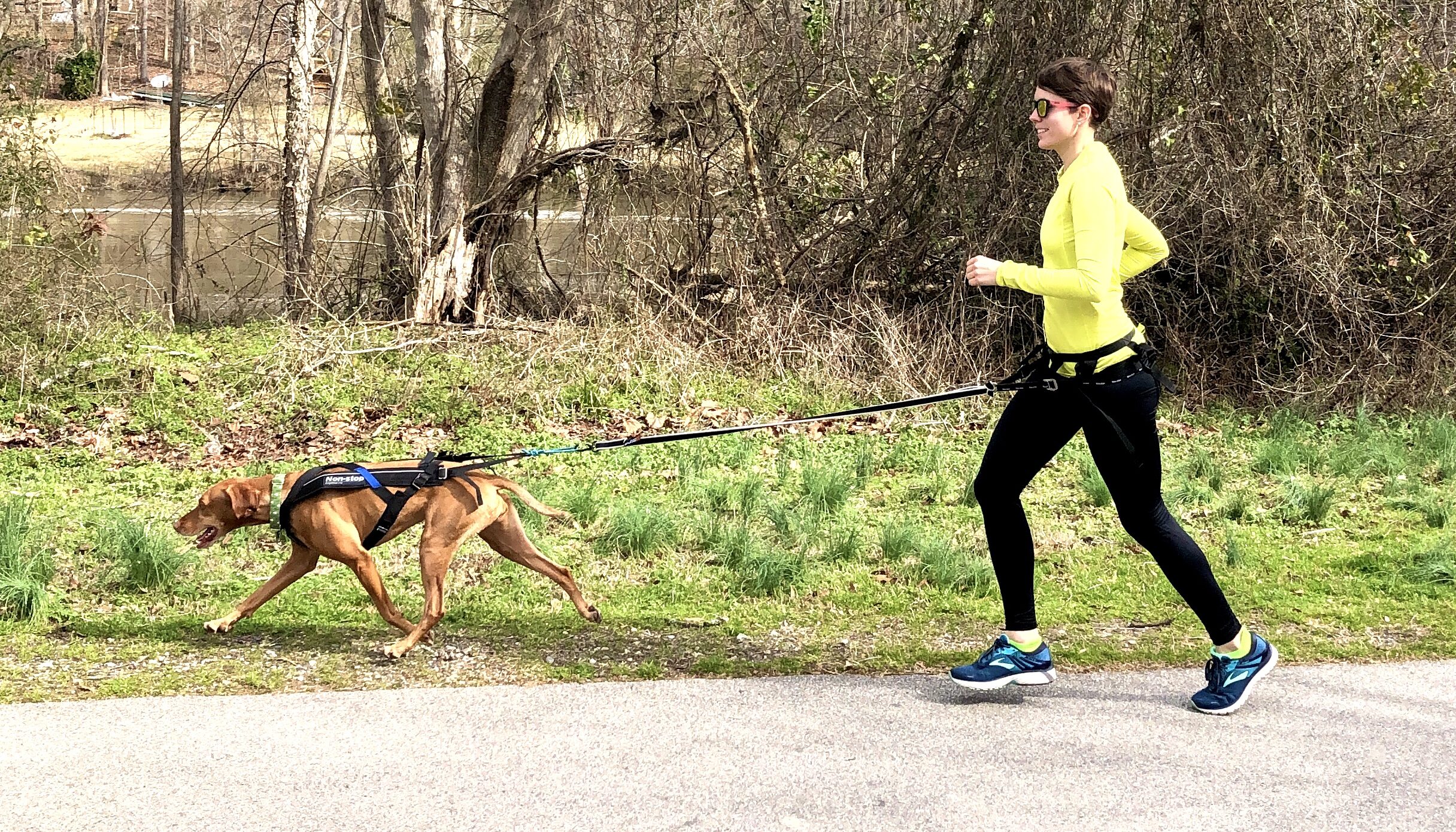
Running a canicross set-up with Zara. She is wearing the Nonstop dogwear Freemotion harness. The pulling definitely increases my speed but can be difficult on my legs sometimes.
Running Gear
In order to make your runs more comfortable, it helps to have a few key pieces of equipment. The first thing to consider is a good running harness for your dog. While you can just attach a leash to your dog’s collar if they’re not a puller, it’s probably going to be more comfortable for them over the long term to wear a harness.
I really like the company Nonstop dogwear, which is based in Finland, but their products are also easy to get in the U.S. They make various running harnesses, including canicross harnesses. Their Freemotion harness is ergonomic and ideal for when your dog pulls you. Zara has one of these and it works well when paired with their bungee leash and human running belt. While their products aren’t cheap, they are well-made and will last for years.
If your dog is not a puller, a more traditional harness will likely work well. We use Nonstop’s Line harness and Ruffwear’s Front Range harness. Both are nicely padded and don’t rub under the dog’s legs. Attach a leash that hooks around your waist to one of these harnesses and you’ll have a good set-up. Ruffwear make several good leash options.
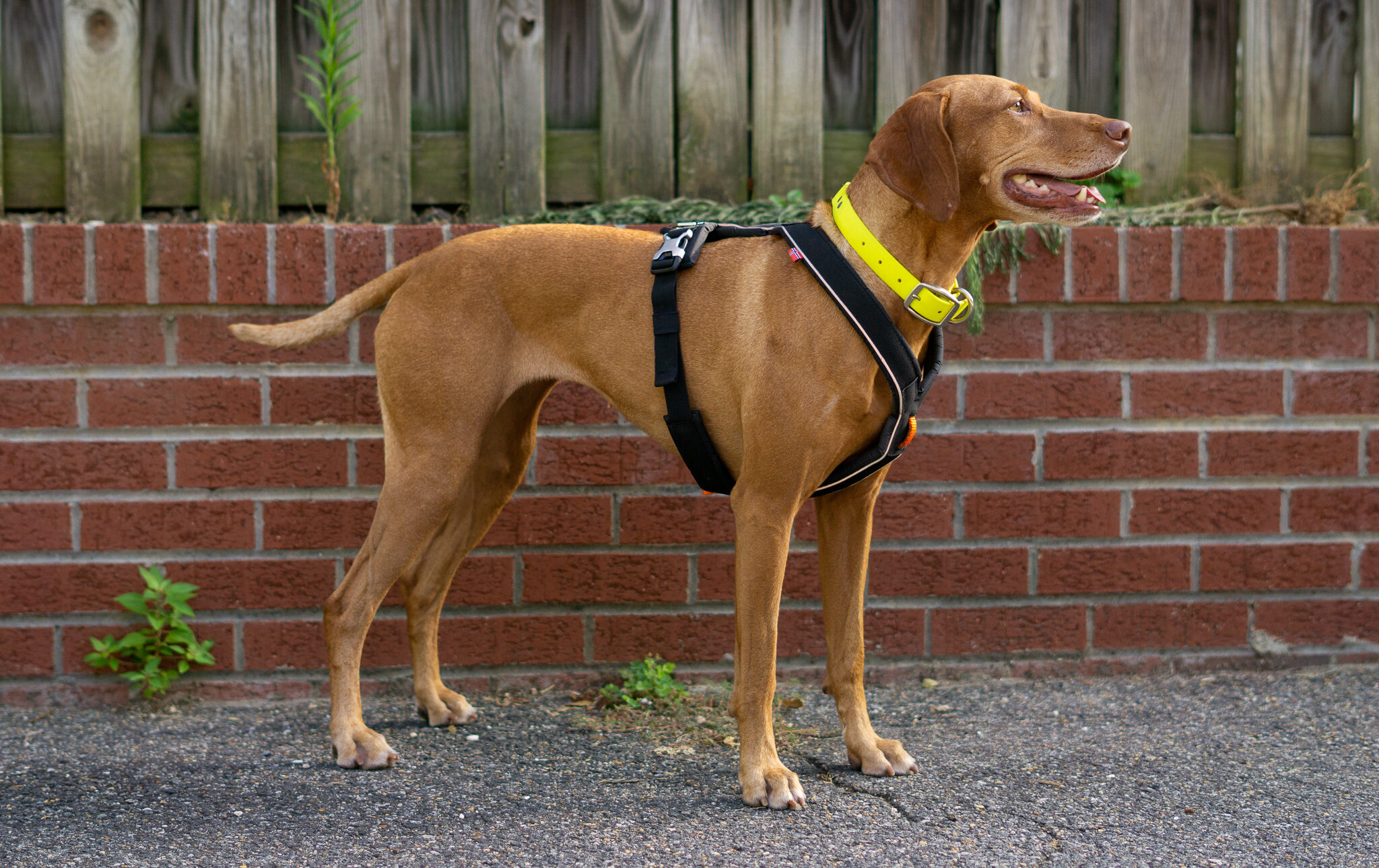
Zara demonstrates the Nonstop dogwear Line Harness
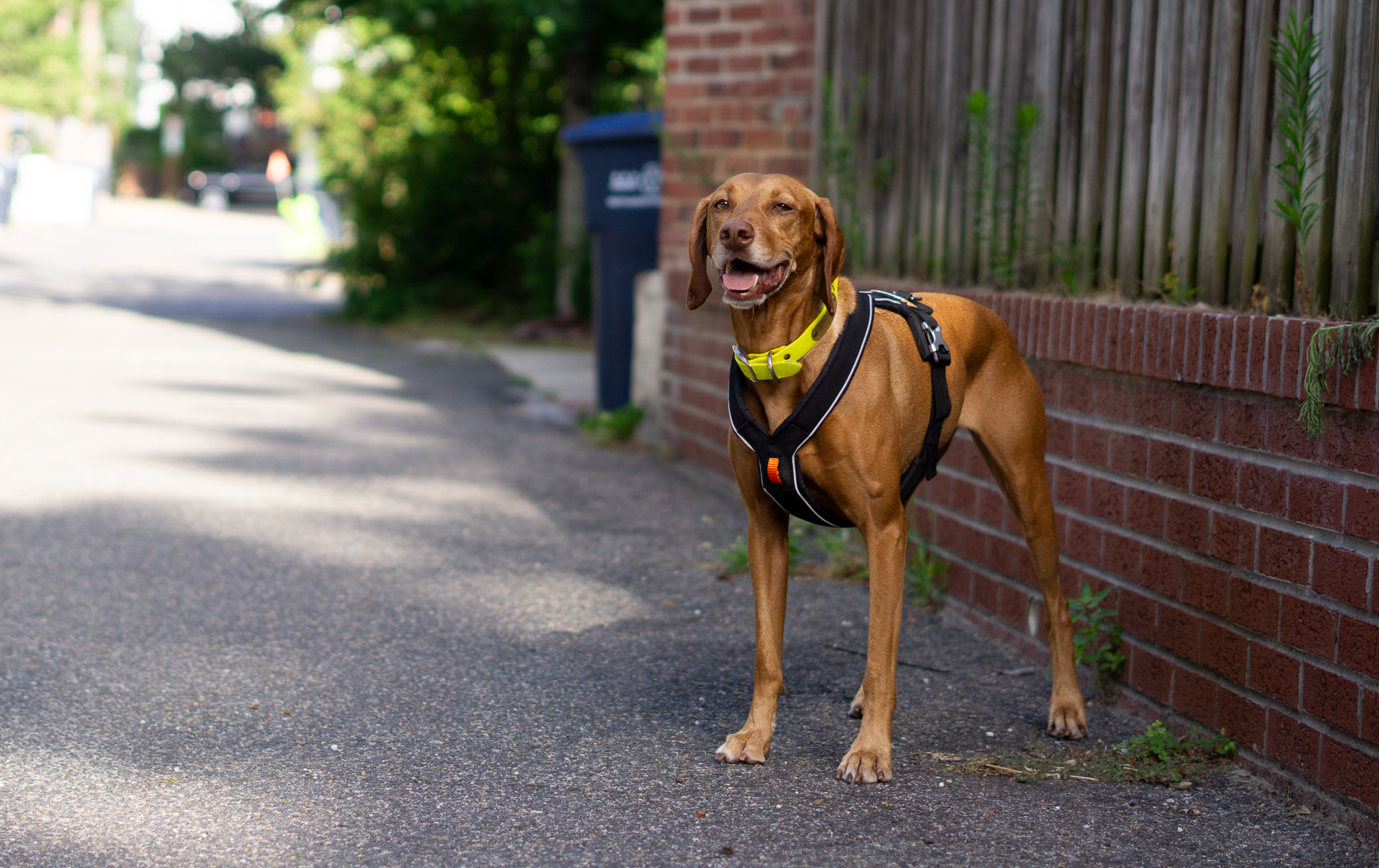
This harness is a great overall running harness.
Starting to Run with Your Dog
When you first start running with your dog, don’t expect perfection. Depending on the dog, it can take time for them to realize what they need to do. They might crisscross in front of you, or want to stop every 2 minutes to pee. It will get better the more you do it. You should also gradually build up mileage. Start with a mile or two once or twice a week. If your dog is in good shape and is a natural athlete (such as a vizsla), they may be able to handle more mileage quicker than others. Over time, your dog may be able to handle quite a bit of running. The longest run we’ve done with Zara is 10 miles, but I’m sure she could go further.
Weather Matters
Watching the weather is important when running with your dog. You especially have to be careful when running in the heat. Since dogs don’t sweat, the only way they have to cool themselves is through panting. Since they also have fur coats, they will almost always be hotter than you are. One general rule of thumb that I find useful is to follow the 140 rule. In the summer, I try not to run with the dogs if the temperature plus dew point equal more than 140. For example, if it’s 85 degrees and the dew point is 73 degrees, that equals 158 and I won’t run them. Given that we live in North Carolina, which is known for its hot, humid summers, the temperature and dew point are often close to 140 even early in the morning.
They can build up some tolerance to heat, but you really have to watch your dog and know what they’re capable of. A dog with a thick coat (such as a husky) is not going to do as well in the heat as a light-colored short-haired dog. Carrying plenty of water on runs is important. I have a collapsible bowl that can clip on my running leash. I either carry a handheld water bottle or wear a running hydration vest.
We do have cooling vests for both dogs, although we honestly don’t use them a lot. You wet the material and it helps keep the dog cool.
Running in the cold is generally easier on dogs than running in the heat. However, when it gets really cold, they may need a coat or sweater to keep them warm. For my dogs, if it’s in the 30s, or really damp, I will put a coat on them. If you run in snow or icy conditions, you may want to consider dog booties to protect their feet. The paw wax called Musher’s Secret can also be applied to protect their pads.
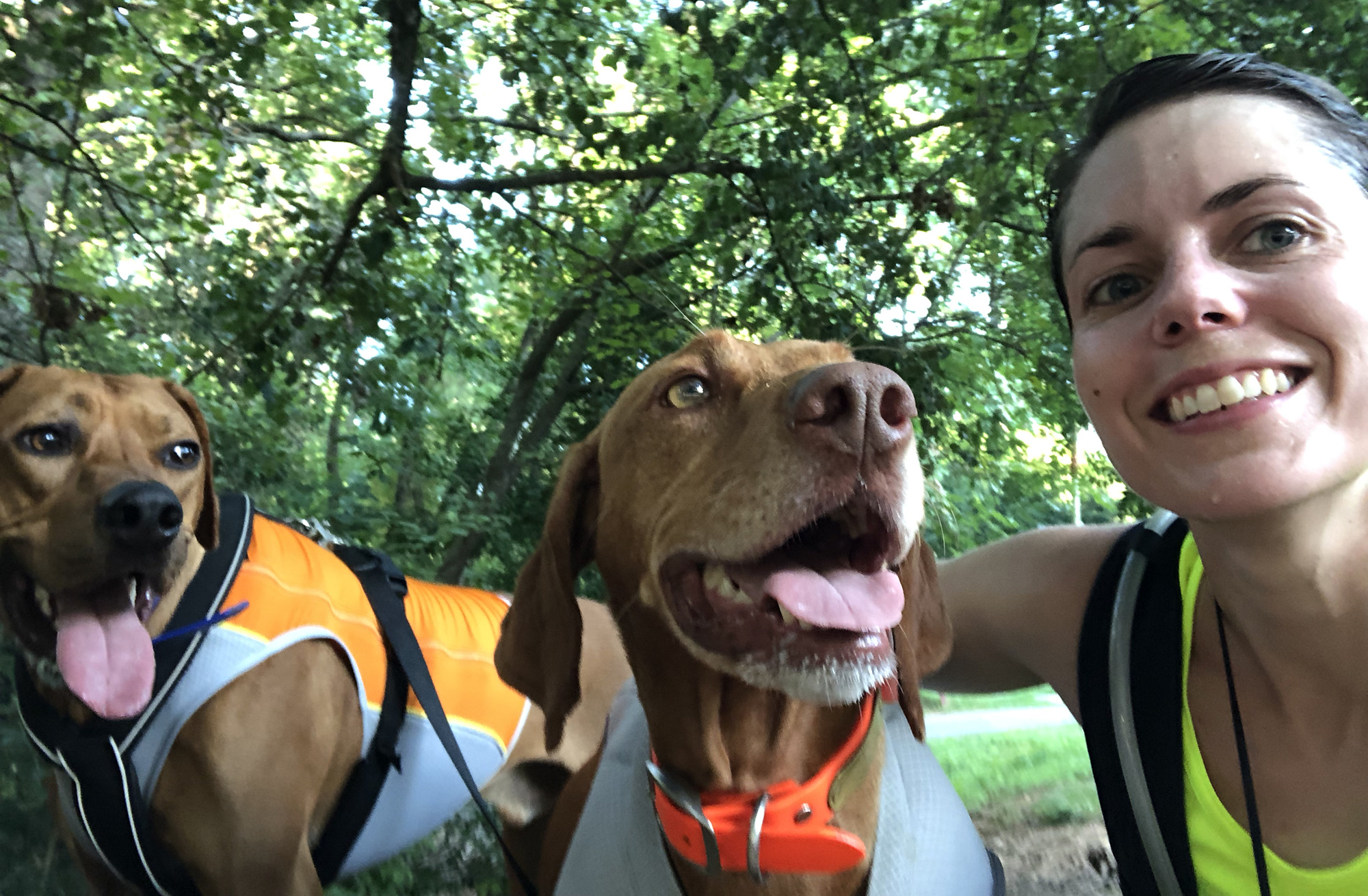
A hot run last summer. Both dogs are wearing their Ruffwear cooling vests.
Races
Running a race with your dog can be a lot of fun! We’ve done several races with the dogs – mostly “fun run” type 5Ks. However, we did do a 12-mile “endurance trial” with Colombo last year at the Rhodesian Ridgeback National Specialty. I will cover this in more depth in a future post.
When preparing to run a race with your dog, it’s important to consider how they do in crowds, with a lot of other people, dogs, kids, and strollers. A race environment might be too much for some dogs. Making sure they’re properly socialized as a puppy can help with this.
Colombo was very distracted during his first race, a 5K we did in November 2018. There were a lot of other dogs and he wanted to say hi to all of them. I just took it slow with him. However, a year later, in November 2019, he was much improved when we ran a 5K on Thanksgiving Day. He ran through the crowded course without a problem. (Obviously, this was pre-COVID…)
Zara is a natural racer. Once she’s off, she’s ready to run – and run fast – the whole time. She doesn’t get distracted by other dogs. When she ran that same 5K in November 2018 with Chris, they won first place out of the dog and human teams!

Colombo’s first race – Santa Paws 5K in November 2018.

Our whole family did a Thanksgiving turkey trot 5K in 2019. I ran with Colombo and Chris ran with Zara. It was in the 30s, so both dogs were wearing fleece sweaters.
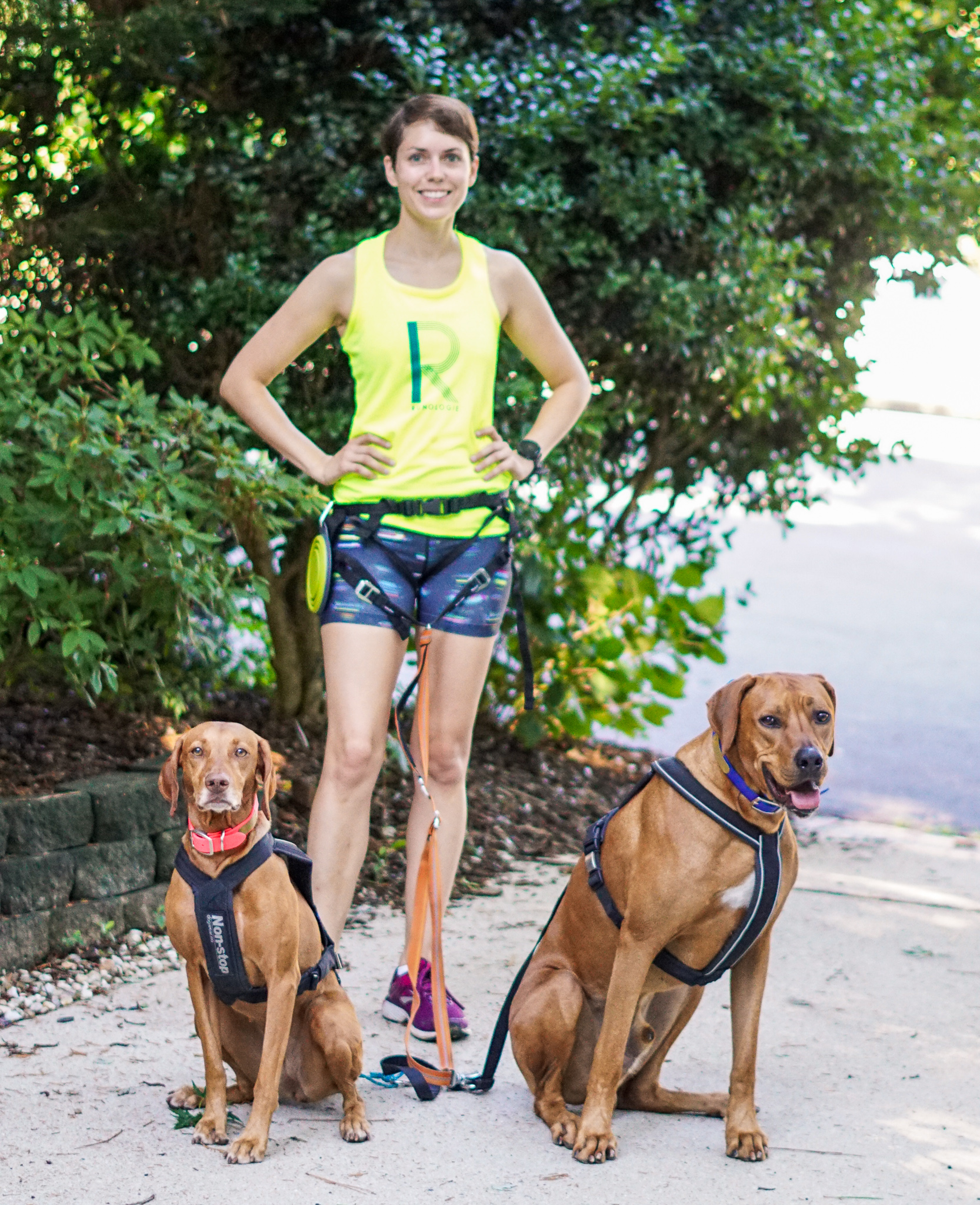
When running with both dogs, I use one leash and a coupler.
Running with Multiple Dogs
Running with more than one dog can be tricky. However, it can also be time-efficient, fun, and necessary. It definitely takes time to train two dogs to run as a team. For about a year, I ran regularly with both Zara and Colombo at the same time. However, I eventually realized that this activity was hard on my knees and I don’t do it much anymore. Even though Colombo typically doesn’t pull, if he does start lightly pulling, the combined weight (140+ pounds) of both dogs is more than I weigh and has contributed to tendinitis in my left knee.
If you’re going to engage in this activity, I’d recommend teaching your dogs not to pull so they run alongside you. I suppose I could do this too…haha.
Running with Dogs is Fun
I really enjoy running with my dogs. It’s more interesting than running alone. They’re always up for it and it’s a great way to tire them out.
Do you run with your dog? Do you have any additional tips? Leave me a comment below!

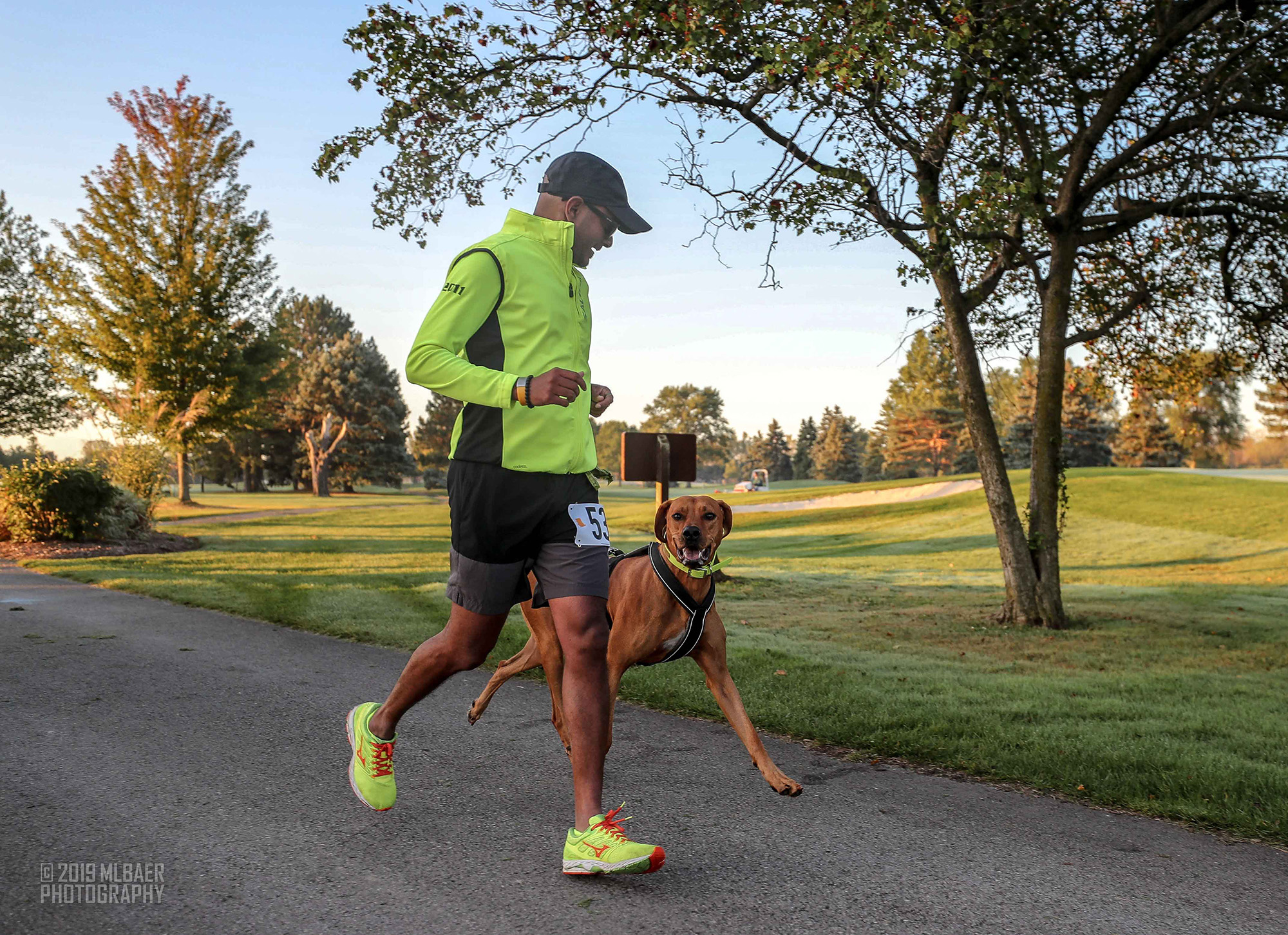



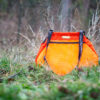


Hi, thank you for great advices. Can you tell me please which size of Nonstop dogwear Freemotion harness and Nonstop dogwear Line Harness are you using with Zara?
Hi Patrik!
Zara wears a size 6 in the Freemotion harness. I remember the size chart being a bit misleading when I first ordered it. I actually ordered a size 5 originally but had to return it and get the 6 because it was too small. She also wears a 6 in the Line harness. She’s about 45 pounds.
Hi Terry Ann, thank you very much!! Great advice, I really couldnt decide if we should try 5 or 6, because for Vizslas the calculator was size 5 until 22 kg (48 pounds) and mine is too around 45 pounds. So we are going for 6 :)). She was 1 year so there is still some room for her to gain weight. So 6 it will be :)) Thank you and for great article also!
Oh good! Yeah, I think you’ll be happy with the 6. Enjoy running!